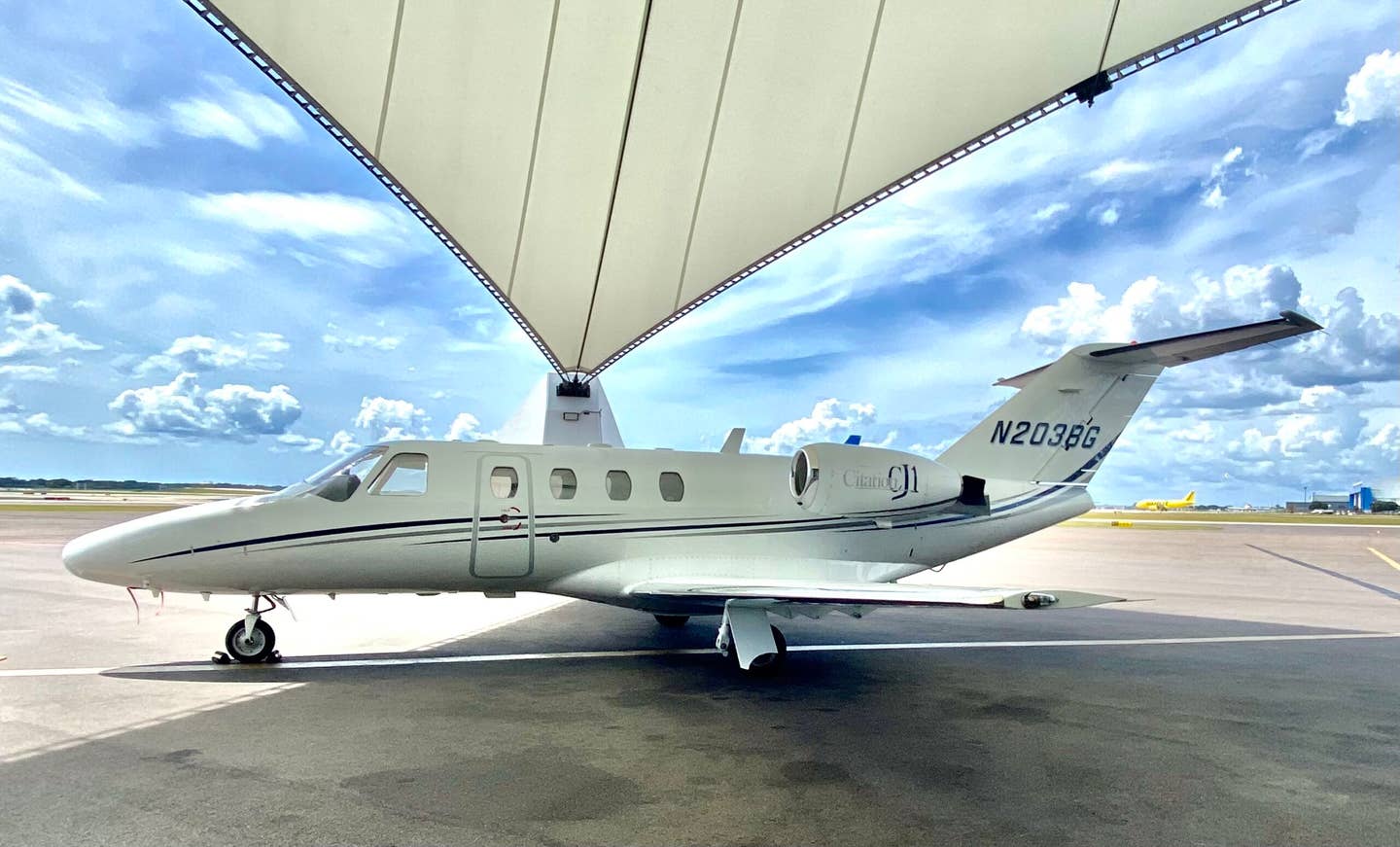
The author’s plane gets ready to leave Signature Tampa for the last time. [Courtesy: Dick Karl]
Our last flight out of Tampa International Airport was short.
After being based at KTPA for 38 years, we were nudged out to a nontowered reliever airport, KVDF, known as Tampa Executive Airport. The flight took six minutes to fly but has taken months to reconcile.
Owning an airplane is a thrill. Sometimes the thrill is just looking at the aircraft on the ramp and thinking, “It’s mine.” Sometimes the thrill is in the maintenance costs. Sometimes the thrill is taking a friend or relative for an airplane ride. Sometimes the thrill is in the hunt for a safe harbor in which to hangar your pride and joy. Once you buy an airplane, hangar space is a worry. Any owner will tell you this.
I’ve owned airplanes while living in St. Louis, Missouri; Louisville, Kentucky; Chicago, Illinois; and now Tampa, Florida. Over many years, financial pressures and space availability have made for semi-constant anxiety.
Will the airplane have a home?
“Over many years, financial pressures and space availability have made for semi-constant anxiety.”
Will the hangar operator find a more attractive tenant?
Can you afford the price increases over time?
When I first moved to Tampa in 1983, I found a hangar for my Cessna P210 at one of the two FBOs at the main airport, KTPA. It was close to my new house. When one FBO closed, I moved across the field to Hangar One, the iconic FBO with two huge canvas sails, one over the entrance and the other over the ramp. Given their suggestive configuration as seen from the air, pilots have long referred to the site (and sight) as the “Dolly Parton.”
The FBO’s name would change to Hawker Beechcraft, Raytheon, Landmark and Signature (among others, I think), but the buildings and the proximity didn’t. Many an evening, after a long day in surgical operating rooms, I’d drive or ride my bike to the airport to visit and admire a succession of increasingly capable airplanes.
Life Changed, But My Hangar Stayed True
The 210 gave way to Cessna 340, which was replaced for 17 years by a Piper Cheyenne. My life changed, too. I raised three kids, got remarried, and moved a few times, but always to a house less than 10 minutes from the airport.
Many of the linemen seemed to be as permanent as the proximity. I was involved in some of their lives. I saw a few as patients, operated on a few of their relatives, dispensed medical reassurance when asked, and generally tried to keep a nondemanding customer profile. My airplanes were often parked near or under airplanes owned by folks who owned the Tampa Bay Buccaneers or the New York Yankees. I was small potatoes.
Over time, my financial and aviation capabilities blossomed, and it seemed that my home FBO was always supportive of my evolution. When I got hired by a Part 135 outfit, I would occasionally arrive at home base in uniform and in a Cessna Citation CJ3. The line guys would laugh; they knew this was a dream come true for me.
Flying 135 made owning and operating a jet feasible for me. I finally had real-world, real-flying experience. I had been schooled by some of the best and I was proud when I bought a Beech Premier 1 jet. The folks at the hangar were enthusiastic—to a point. Roland, whom I had known for 30-plus years, offered his congratulations and then said he had just one question:
“Is it single-point?”
He was asking about ease of fueling. Not long ago, he asked me to help his daughter write her essay for admission to medical school. That was easy, she’s a superstar and will soon be a doctor.
The Change That Hurt
After almost 40 years in the same hangar, I had begun to relax. It seemed we were safe. And then, last summer, came an unwelcome surprise. A hostile accusatory letter from the general manager at Signature Flight Support Tampa and notice of a steep price increase told me that we were no longer wanted.
Oh, my goodness, it finally happened. I get it; there are bigger jets out there than our Cessna CJ1. They burn more fuel and cost more to hangar. Still, the coldness of the rejection stung. I was sleepless for several nights. I just couldn’t come to grips with a change I had finally concluded was unlikely.
New space has been found at KVDF. The people there have been incredibly nice. The hangar price is reasonable, and gas is cheaper by a little. Still, I am as dislocated as a teenager whose family has moved across the country.
In the end it became clear. We would move to cheaper, more welcoming, digs. Now retired, I can drive to a reliever airport without any trouble, though the interstate is a truck and muscle-car gauntlet.
It will be OK, though. Mostly though, I’ll miss the linemen. I thought of them as friends.

Subscribe to Our Newsletter
Get the latest FLYING stories delivered directly to your inbox






